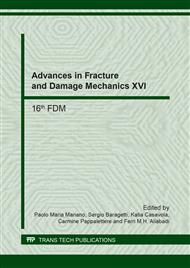[1]
I.C.H. Hughes and J. Powell: SAE Paper 840772 (1984).
Google Scholar
[2]
D.M. Stefanescu, R. Hummer and E. Nechtelberger: ASM Handbook 15 (1988): pp.667-677.
Google Scholar
[3]
F.C. Campbell: Elements of Metallurgy and Engineering Alloys (ASM International, Ohio 2008).
Google Scholar
[4]
R. Elliott: Cast iron technology (Butterworth-Heinemann, London 1988).
Google Scholar
[5]
C. Fragassa, N. Radovic, A. Pavlovic and G. Minak: Tribology in Industry 38. 1 (2016), pp.49-59.
Google Scholar
[6]
C. Fragassa and A. Pavlovic: FME Transactions 44. 4 (2016), pp.327-332.
Google Scholar
[7]
C. Fragassa, R. Zigulic and A. Pavlovic. Engineering Review 36. 3 (2016), pp.269-280.
Google Scholar
[8]
C. Fragassa, G. Minak and A. Pavlovic: Tribology in Industry 38. 1 (2016), pp.1-10.
Google Scholar
[9]
C. Fragassa: Proceedings of the Institution of Mechanical Engineers, Part C: Journal of Mechanical Engineering Science Vol 231. 1 (2017), pp.18-30.
Google Scholar
[10]
G. Lucisano, M. Stefanovic and C. Fragassa: International Journal of Quality Research 10. 1, pp.143-158.
Google Scholar
[11]
J.D. Altstetter and R.M. Nowicki: AFS Transactions 82-188 (1982), pp.959-970.
Google Scholar
[12]
S. Dawson and T. Schroeder. AFS Trans., 112. 5 (2004), pp.813-821.
Google Scholar
[13]
W. Guesser, T. Schroeder and S. Dawson: AFS Transactions 01. 071 (2001), pp.1-11.
Google Scholar
[14]
N. Radović, A. Morri and C. Fragassa: In Proc. of the 11th IMEKO TC15 Youth Symposium on Experimental Solid Mechanics (2012), pp.185-190. A study on the tensile behaviour.
Google Scholar
[15]
S. Dawson: Vdi Berichte 1472 (1999), pp.85-106.
Google Scholar
[16]
A. K. Sinha: Physical metallurgy handbook (McGraw-Hill Professional Publishing, 2003).
Google Scholar
[17]
H. T. Angus: Cast Iron: Physical and Engineering Properties (Elsevier, London 2013).
Google Scholar
[18]
A. Cai, H. Wu and al.: China Mechanical Engineering 21. 7 (2010), pp.868-871.
Google Scholar
[19]
E. Flamigni and G. Pasini: Metallurgia Italiana, 96. 5 (2004), pp.37-41.
Google Scholar
[20]
G.F. Geier, W. Bauer, B.J. McKay and P. Schumacher: Materials Science and Engineering A, 413-414 (2005), pp.339-345.
Google Scholar


